Peavey Classic 30 Mod / Repairs
Here is some info on two different Peavey Classic 30s we have worked on.
January 2019
We were asked to try to repair one of these. It had a bad background noise, and was very weak. The owner had also been having trouble with the power tubes becoming loose (which apparently has been an issue with some versions of these amps).
The noise and weakness issue turned out to be a simple case of failing power tubes (of the 4 output tubes, two of them had shorts, and one was weak). One of the original power tube "keepers" was also missing. After replacing the power tubes with a matched set of JJs, the amp was again performing as expected. However, it was still missing the power tube "keeper". Plus, the tubes were pretty exposed from the back of the amp. We did the following to address these issues.
First, we created a rig to better hold the power tubes in place. This was based on a design we had seen online that someone else had come with called a "Tube Tamer". I believe the person that came up with this was, at some point, selling them on ebay, but I don't see them there anymore. Theirs was based on a piece of metal conduit, with rubber grommets in the holes that the top of the tubes stuck into, but we just used a piece of 1/2" plastic PEX water pipe with holes, and did not use any grommets.
Basically, we cut a piece of 1/2" plastic PEX water pipe, drilled 4 holes for the pointy tube tops, and 2 holes for 2 springs. We then removed the remaining 3 tube keepers, and used the two end brackets on the tube sockets to attach the springs that hold the piece of pipe against the tubes.
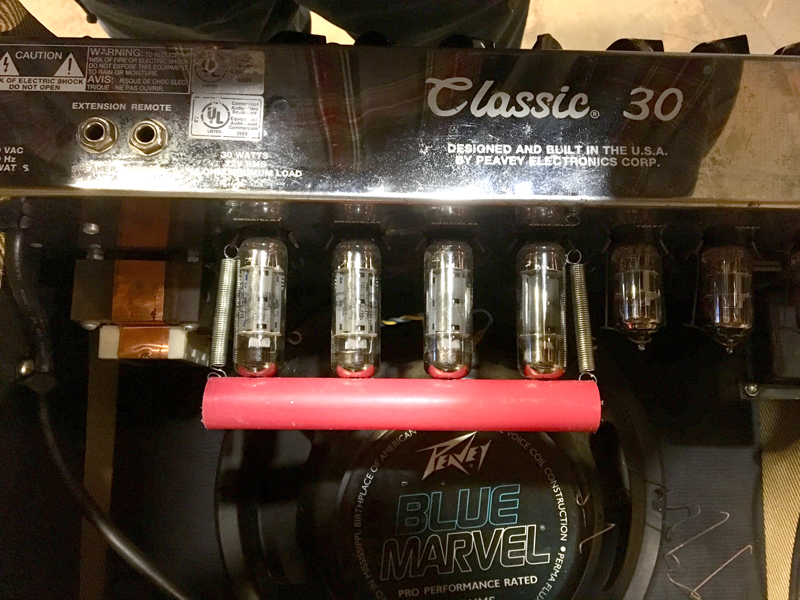
PEX water pipe tube keeper
To protect the tubes, we planed a piece of mahogany down to 1/2" thick, cut it to size, and drilled some vent holes it it. We added some small blocks of wood to the cab to hold this panel, and attached it with some screws so it can be removed for access to the tubes.
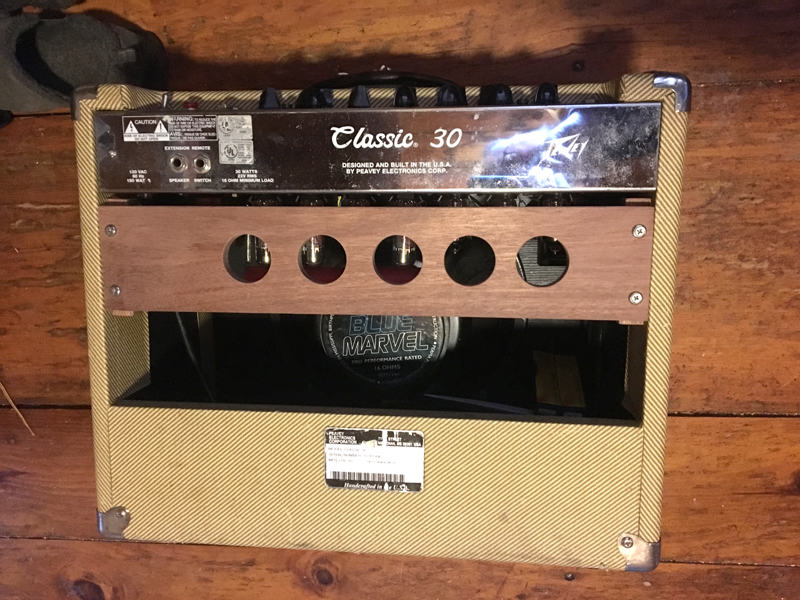
Back panel to protect the tubes
Hopefully, these mods will make the amp a bit more robust.
Update: This amp came back a few months later - it was intermittently dying after a few minutes of being turned on, then just died and would not come on at all. We could see that the power tube filaments were not lighting up. We ended up pulling the chassis this time, and found that one of the jumper wires on the folded circuit board assembly had broken. Turns out, this jumper wire was part of the power tube filament circuit (the filaments of the 4 power tubes are wired in series, so one break will kill all 4 of them). We repaired the jumper, which fixed the issue. The folded circuit board configuration of these amps makes for difficult repairs if the circuit board needs to be removed for service, as these jumpers get flexed, and can be easily broken. Fortunately, we found this one, and were able to repair it without actually removing the board from the chassis. We didn't take a picture of this, but for the next Classic 30 we worked on (below), we did have to remove the boards to repair some bad solder joints on one of the power tube sockets, and we did take a few pictures.
UPDATE #1:
July 2021 - This amp came back to the shop. This time, it now has a bad static / crackle issue. Substituting tubes and cleaning the tube sockets did not seem to cure the issue, so we are probably looking at removing the circuit boards and looking for bad solder joints. We did find bad solder joints on another Classic 30 on one of the power tube sockets a while ago (see below), so hoping this issue won't be too hard to isolate.
October 2019
Another Classic 30 came into the shop. This one was getting power as well (that is, the pilot light was lighting up), but no sound, like the one above. We discovered that one of the power tubes was cracked, and it fell apart into several pieces when removed. This amp actually has a cage protecting the tubes, so how this happened is a bit of a mystery. Two of the other power tubes, and one of the preamp tubes also tested bad. We substituted in some used, known OK, tubes, and, initially, the amp seemed to perform well. The initial thought was that this amp just really needed a full set of new tubes. We usually like to be sure we have healthy tubes installed before do too much more stress testing.
However, the customer decided that they didn't want to spend the money it would take to re-tube this amp, as it wasn't an amp they really liked that much, and it was really bigger than they needed. We know someone who may be in the market for one of these, so we ended up buying it from the customer "as is". The plan was to clean it up (it was just pretty dirty, but the cab was actually in pretty good shape), get some good tubes in it, and sell it.
Turns out, this was probably a good turn of events for both of us. After putting our used tubes back in, and playing through it some more, we discovered that one of the power tube sockets seemed funky - moving the tube created all sorts of crackling that had not been previously apparent. We ended up pulling the chassis, removing the circuit board (these are kind of a pain to remove, due to the folded design of the circuit boards), and re-soldering all of the tube sockets to the board, which fixed the issue. This cost us an extra hour or so of labor, but at least it didn't go back to the customer in this condition (this would have been an even more expensive repair than just a re-tube).
Here are a few pictures of this process. Unfortunately, we didn't take any pictures of it before we cleaned it up, but we did take some pictures of the repair process. First, we took some pics of the wiring harness plugs, so we could get them plugged back in correctly when reassembling.
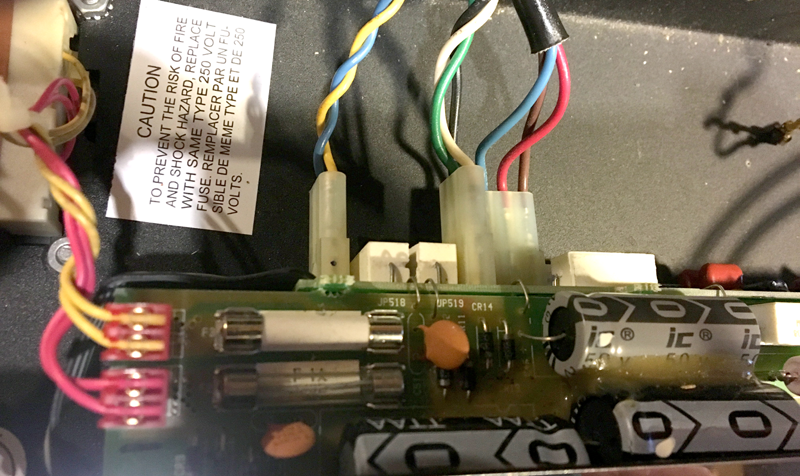
Pics of wiring harness plugs before removal
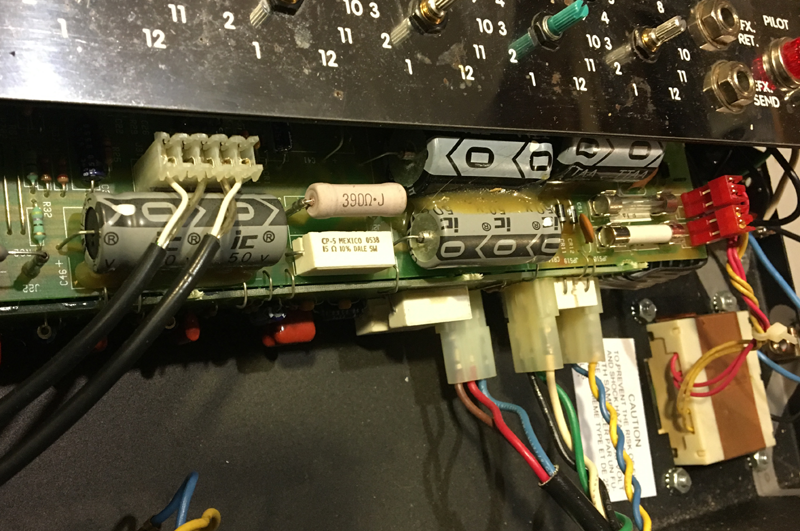
Pics of wiring harness plugs before removal
We had read in a number of forum posts some complaints about what a pain it was to remove the boards from the chassis, but it ended up not being so bad. Once the pot and jack nuts had been removed, and the screws holding the tube sockets to the chassis had been removed, the folded board can be folded a bit more, and it comes right out. One just has to be a bit gentle so as not to stress the little jumpers that run between the board pieces. These apparently have a tendency to break fairly easily(see above notes on the first Classic 30 we worked on).
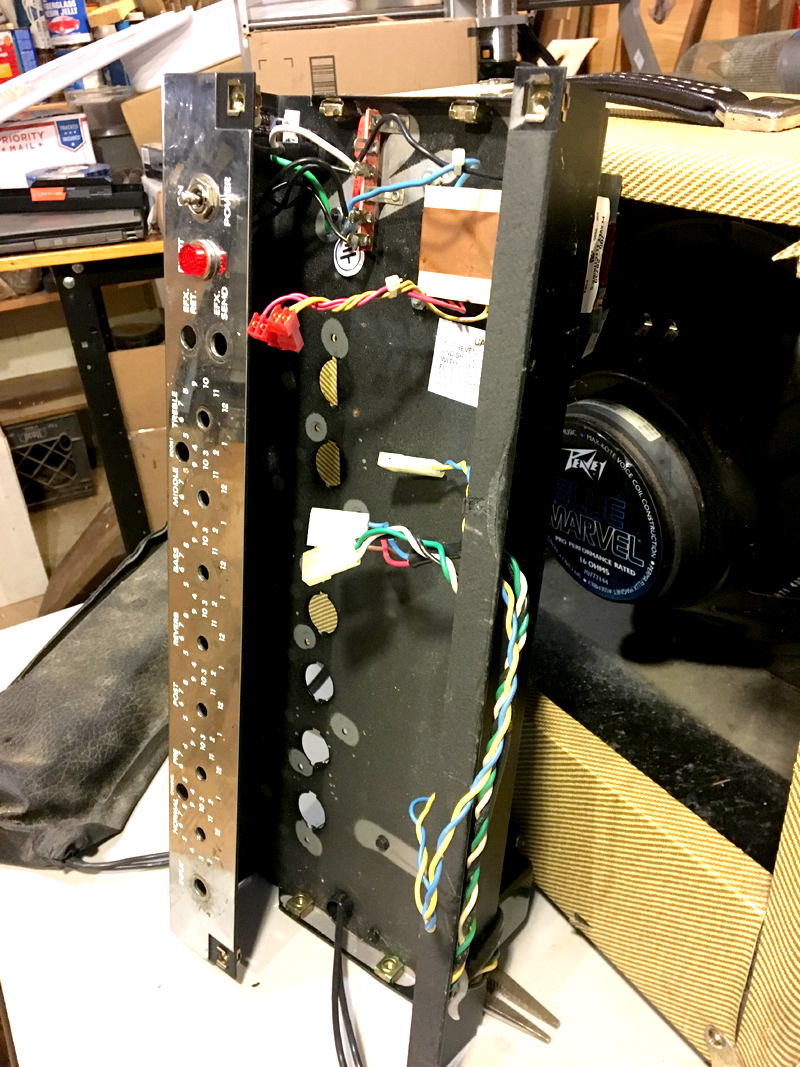
Chassis with circuit boards removed
Here are a couple of views of the folded circuit board. In the second picture, we have circled the suspect socket.
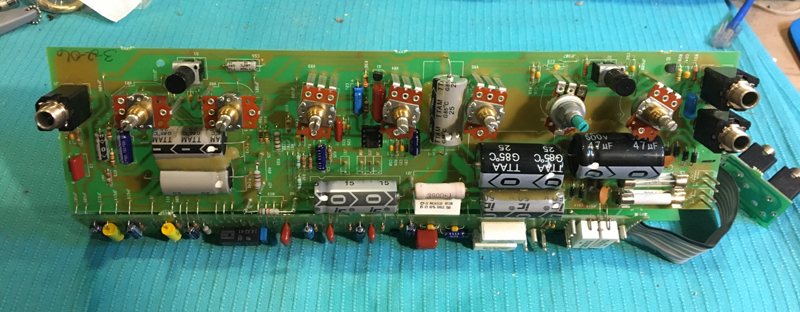
Folded circuit board
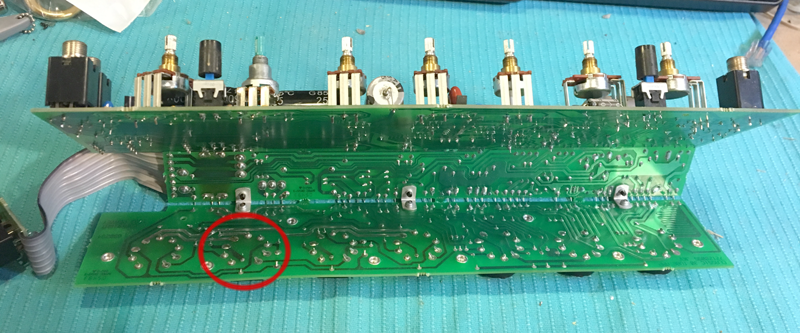
Folded circuit board - suspect socket circled
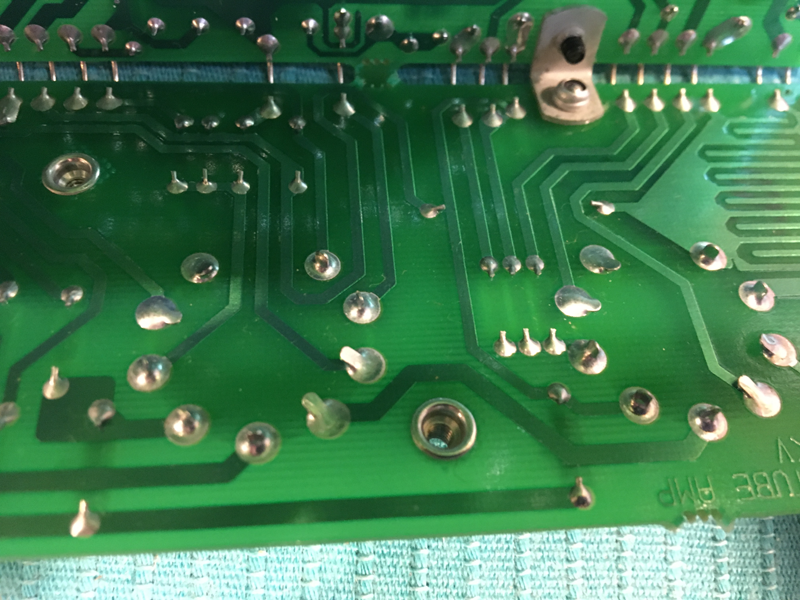
Two of the power tube sockets, plus a view of the jumper wires between boards
Sometimes, a bad solder joint is visually fairly obvious, but in this case, not so much.
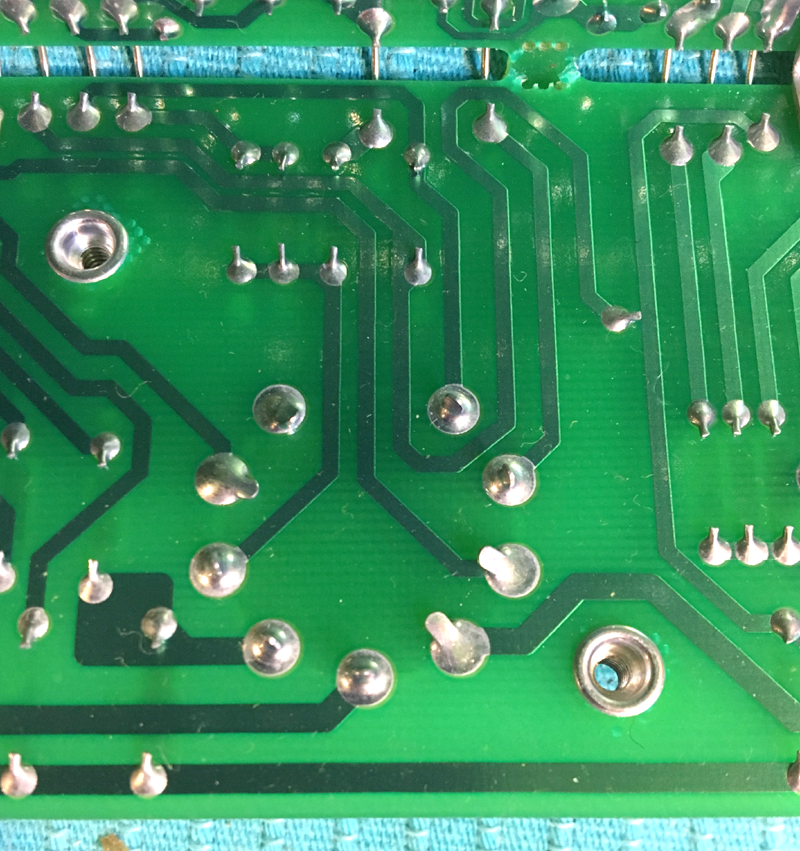
Closeup of suspect socket
We ended up re-flowing the solder on all 7 tube sockets on general principles while we had access to them. We also sprayed contact cleaner into all of the pots and switches.
While the chassis was out of the cab, we cleaned up the cab using some Simple Green general cleaner, which worked well on the vinyl covering. We also cleaned up the chassis face using some WD-40 on a rag. Don't want to use anything too caustic on the face plate, as the lettering comes off fairly easily. The WD-40 removed the dirt and gunk pretty well. Though it won't fix any existing damage, it will help prevent further corrosion.
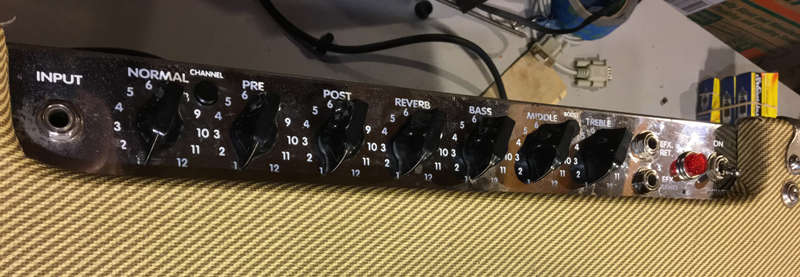
Face Plate cleaned up
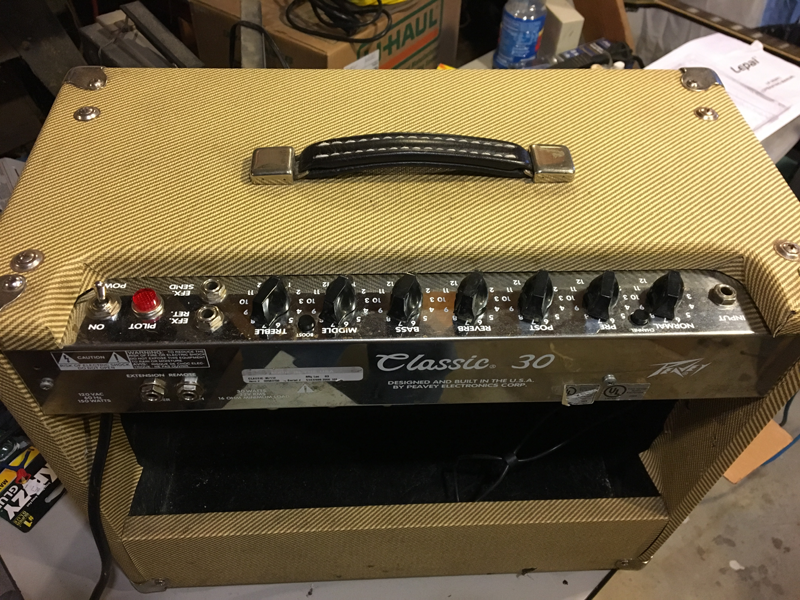
Face Plate cleaned up
After cleaning everything up, we reassembled it all, and installed our used, OK, tubes. It now seems solid, and sounds great, though we then discovered that the reverb was not working. Some testing revealed that the tank itself was bad (the output transformer on the tank transducer was open). We connected a spare tank we had that is not quite a proper impedance match, and it worked (well enough that we could determine that the circuit driving the reverb is OK), so we ordered a replacement tank we found on eBay. Once we get that installed, it should be a solid amp. Depending on its future role, we may end up re-tubing it as well.
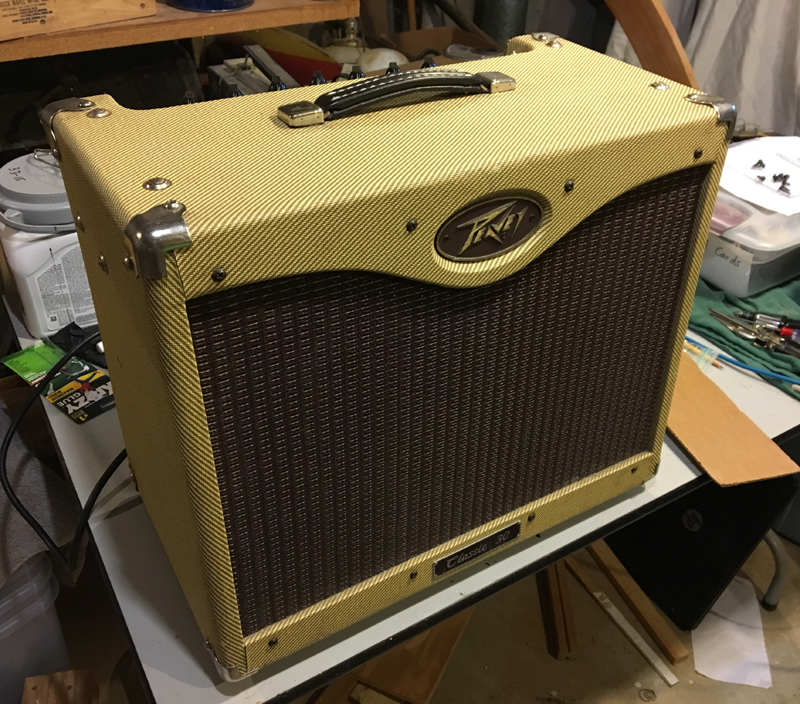
Cleaned up, waiting on replacement reverb tank
When the reverb tank arrived from eBay, we installed it and now the reverb is working well. I was pleased to find that Peavey uses the Accutronics tanks, at least for their Classic series. These are the same tanks Fender has used, and I have always liked the Fender reverb sound.

Reverb Tank from eBay

Reverb Tank from eBay (note code)
These come in all sorts of configurations, depending on the length, number of springs, and imput and output impedances. These are all specified in the part number / code.
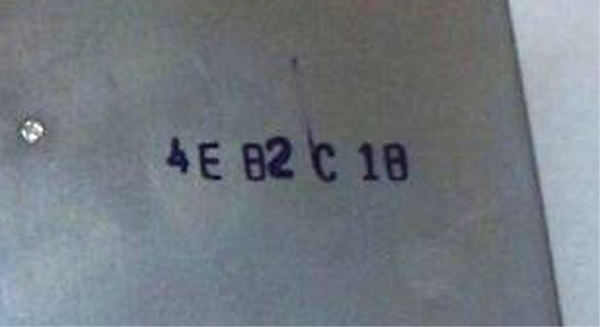
Acutronics Code
In this case, the code is 4EB2C1B, which translates to:
Accutronics Codes |
||
Type |
4 |
17" long, using 2 long springs |
Input Impedance |
E |
600 Ohms |
Output Impedance |
B |
2250 Ohms |
Decay Time |
2 |
Medium (1.75 to 3.0 Seconds) |
Connector Arrangement |
C |
input insulated, output grounded |
Locking Device |
1 |
None |
Mounting Plane |
B |
horizontal, open side down |
The Peavey uses solid state chips to both drive and recover the reverb, thus the impedance for both the input and output are set to match the solid state circuit. The older Fender tube amps used tubes to drive and recover the reverb, so the impedance for both the input and output would be different to match the tube circuit. Otherwise, this tank, and the common Fender tanks are very similar.
This now seems to be a solid, and happy, amp!
UPDATE #1:
We did end up selling this to the friend who was looking for one of these. He has gigged with it a number of
times, and it has been working well.
UPDATE #2:
July 2021 - This amp came back to the shop. This time it looked like it had power (pilot light on, all tube filaments lit), but was not producing any sound. If we patched into the return jack (direct to the input of the power amp section), we got some sound, about as much as you would expect from that stage. All tubes tested more or less OK, and substituting some others in did not change anything. After removing the circuit boards from the chassis (kind of a chore - see above), we found a burned resistor in the power supply. Basically, neither of the first two preamp tubes were getting any plate voltage. This resistor is a 1 watt 30k ohm resistor, which we did not have in stock, so we ordered some. We will post some pictures, and update progress on this once they come in.
